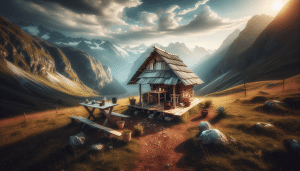Discover Secret Train Routes for Unforgettable Journeys
Daniel Fisher September 4, 2025
Hidden train routes offer a chance to see remarkable landscapes, meet locals, and enjoy slow travel at an affordable price. Explore how overnight trains, scenic railways, and sleeper carriages transform travel experiences for people seeking adventure and relaxation.
Embracing the Romance of Sleeper Trains
Traveling by sleeper train brings a sense of nostalgia and adventure back to modern journeys. As you glide through mountains and countryside under a starry canopy, sleeper trains offer unique opportunities to relax and soak in panoramic views that remain hidden from highways and busy airports. Modern sleeper railways blend privacy with shared experiences in communal dining cars, where conversations bloom between travelers from different backgrounds. For many, the rhythm of the train itself offers a calming lullaby, making restless nights rare and memorable mornings common. Exploring sleeper train options creates new opportunities to travel affordably, comfortably, and with a touch of old-world charm.
Overnight trains connect major cities and lesser-known gems, often unlocking destinations that are difficult to reach by plane or bus. In Europe and Asia, iconic routes like the Paris to Venice sleeper and the Trans-Siberian Railway draw in those searching for longer, immersive travel. Onboard amenities now often include private compartments, Wi-Fi access, and gourmet meals, combining comfort with adventure. While speedy travel has its place, those who choose sleeper trains embrace the journey itself as a highlight, turning transit time into a restful and social experience. No airport security lines. Less stress. Just kilometers of rolling scenery outside your window.
Sleeper trains appeal not only to solo adventurers but also to families and groups seeking togetherness. Spacious compartments can be booked for privacy, while shared cabins introduce a spirit of community. Many routes are more affordable than flights, especially when considering an overnight train replaces a night in a hotel. For communities served only by rail, sleeper trains sustain local economies and provide lifelines for commerce and cultural exchange. By embracing overnight rail, passengers expand the possibilities of travel while making responsible, often lower-emission choices.
Exploring Unspoiled Scenic Railways
Scenic railways transport you into landscapes untouched by modern highways and urbanization. Mountain trains, like Switzerland’s Glacier Express, pass rugged peaks and sparkling lakes with a front-row seat to nature’s wonders. These journeys cater to photographers, nature lovers, and anyone seeking an immersive, slow-paced escape from the pressures of bustling cities. Comfortable panoramic windows, open observation decks, and even glass-domed carriages let passengers soak in every moment. Scenic train routes offer an alternative to crowded tourist destinations, revealing immense beauty often missed by travelers in a hurry.
Many scenic train routes have become destinations themselves, drawing people from around the world. The Jacobite Steam Train in Scotland, for example, is known for crossing the iconic Glenfinnan Viaduct, with views that rival any coastal road. These stretches often feature stops in charming small towns, encouraging spontaneous exploration and authentic local encounters. A single ticket might open doors to centuries-old castles, remote hiking trails, and crystal-clear rivers. For families, scenic trains provide a hassle-free way to travel with children while teaching them about nature and geography along the way.
Underlying these journeys is a renewed appreciation for preservation. Many scenic rail lines support conservation efforts, educating riders on local flora and fauna. Financial contributions from tourism help fund track upkeep and environmental programs. By choosing scenic railways, travelers contribute directly to maintaining vital habitats and supporting regional economies. The experience is both visually rewarding and meaningful, turning each mile into memories and positive impact.
The Comfort and Sustainability of Rail Travel
Modern train travel balances comfort and sustainability better than many other transportation modes. Trains often emit significantly less carbon dioxide per passenger compared to airplanes or cars, especially on electrified networks. Energy-efficient systems and reduced land impact make rail a preferred choice among eco-conscious travelers. Onboard, ergonomic seating, plug-in stations, and fresh meal offerings redefine the idea of long-distance travel for passengers of all ages. It is possible to work, relax, and socialize without the confinement of airplane seats or the fatigue of long drives.
Railway infrastructure continues to evolve, and electrification is increasingly utilized worldwide. High-speed rail lines link city centers directly, bypassing airport transfers and delays. Sustainable design extends to recycling programs onboard, renewable energy sourcing, and partnerships with green suppliers. Some routes even offer bi-level sleeper cars and family-friendly lounges to encourage inclusivity. As more people become aware of the impact of their journeys, environmental advantages make trains a responsible way to explore cherished destinations while reducing travel’s ecological footprint.
Comfort on modern trains extends far beyond plush seats. Trains are typically accessible to travelers with mobility needs, families with strollers, and large groups. Pet-friendly compartments and flexible ticketing policies make it easier for everyone to participate. Free Wi-Fi and entertainment platforms mean productivity does not stop on board. At night, sleeper cars convert seating into flat beds, maximizing privacy and rest—especially valuable for cross-country and transcontinental adventures. All these features combine to make rail an appealing option for diverse traveler preferences.
Hidden Routes and Lesser-Known Destinations
Secret train routes, often overlooked on mainstream maps, charm experienced travelers eager for something different. Lines like Spain’s “Tren de la Robla” wind through Basque countryside that larger routes bypass. Journeying along these paths invites discovery—of new languages, regional cuisine, and traditions unchanged by mass tourism. Ticket prices are typically affordable, and stations are less crowded, providing a stress-free environment from departure to arrival. Each stop gives a glimpse into authentic local life, unfiltered and full of surprise.
Travelers can cross entire regions on historic railways that have been recently revived or modernized. Some American heritage trains, like the Empire Builder or the Coast Starlight, traverse remote stretches of the Pacific Northwest and Rocky Mountains, offering windows into rural Americana. Elsewhere, luxury trains like India’s Palace on Wheels follow routes crafted for royalty, pairing opulence with off-the-beaten-path adventure. These less-traveled railways frequently become new favorite routes for those who want to skip crowds and experience something genuine.
Many of these secret routes integrate with larger rail networks, making it possible to string together journeys across countries and continents in comfort. Thrifty travelers can take advantage of regional rail passes, often valid across several routes, allowing spontaneous stops and extended stays. Route planners and rail enthusiast communities share insights on rare connections and seasonal train specials that are easy to miss. Following their advice, passengers discover hidden gems and create unique travel narratives beyond guidebook suggestions.
Practical Tips for Planning Your Train Adventure
Planning a memorable rail journey starts with choosing the right route. Research is key—many websites and platforms aggregate timetables, ticket options, and availability in real time. Consider whether a rail pass covers your target routes or if individual tickets provide better value. When planning overnight train segments, understand cabin categories, from shared couchettes to private en-suites, and reserve in advance for peace of mind. It helps to pack light yet bring snacks, a camera, and entertainment for longer segments.
Traveler safety is top priority. Reliable resources, such as national railway websites and travel advisory portals, provide updated information on weather, service interruptions, and health recommendations. Seniors, solo travelers, and families can find dedicated guides for their specific needs. Learning basic phrases in local languages enhances the journey and helps foster goodwill with conductors and fellow passengers. For international trips, research visa requirements and customs policies, as crossing borders by train is often smoother but still subject to regulations.
Staying flexible and open-minded is part of the magic of train travel. Delays can happen, but they create opportunities for spontaneous exploration in station towns and unplanned connections with locals. Many stations have staffed information centers, luggage storage, and local market stalls. Travelers interested in sustainability can look for operators recognized for reducing emissions and supporting local causes. Planning with curiosity and care unlocks endless adventures and stories worth sharing.
Unlocking Unique Memories with Train Travel
Train travel stands apart for the moments it creates—shared laughter in communal dining cars, the thrill of sunrise over mountain passes, and the calm that comes as tracks stretch endlessly out the window. The slow pace lets places reveal themselves gradually, deepening appreciation and offering time to reflect. Collectors of travel memories find rail journeys among their most treasured experiences. Photographs, ticket stubs, and stories endure longer than fleeting snapshots from planes.
Many travelers form lasting friendships with others met on trains. Language barriers dissolve over meals served by passing landscapes. Children of all ages are entertained by changing scenes, while older passengers cherish the chance to revisit childhood vacations or discover new ones. For some, rail journeys become traditions, with families returning year after year to the same favorite routes. Others find inspiration in creating personalized itineraries that stretch across continents and generations.
As interest in responsible travel grows, more people return to trains for their environmental, social, and emotional rewards. Choosing rail over other modes not only lightens the environmental footprint but also enriches the travel experience. The days spent on rails are about much more than reaching a destination—they are about discovery, relaxation, and finding joy in the journey itself. Boarding a train could be the start of your next unforgettable adventure.
References
1. European Union Agency for Railways. (n.d.). Environmental impacts of rail transport. Retrieved from https://www.era.europa.eu/content/environmental-impacts-rail-transport_en
2. Swiss Travel System. (n.d.). Glacier Express: Switzerland’s slowest express train. Retrieved from https://www.myswitzerland.com/en-ch/experiences/route/glacier-express
3. Amtrak Media. (n.d.). Overnight train travel in America. Retrieved from https://www.amtrak.com/take-the-train/overnight-train-travel
4. United Nations World Tourism Organization. (2021). Responsible travel and sustainability. Retrieved from https://www.unwto.org/sustainable-development
5. Network Rail. (n.d.). The benefits of train travel. Retrieved from https://www.networkrail.co.uk/communities/passengers/the-benefits-of-train-travel/
6. Seat61. (n.d.). Train travel guides and tips. Retrieved from https://www.seat61.com








